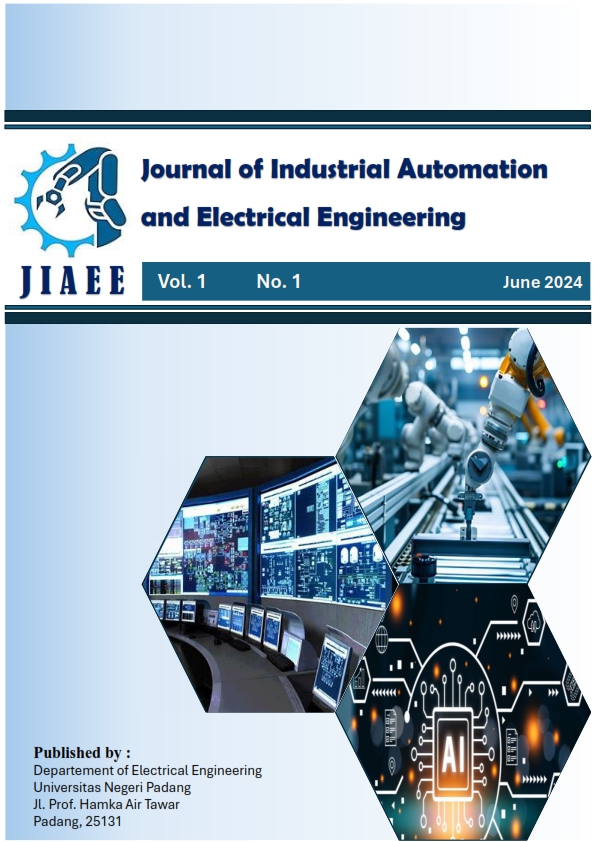Design and implementation of buck-boost converter using Atmega 8535 microcontroller
Keywords:
Buck boost converter, Microcontroller, Atmega 8535, MOSFETAbstract
To achieve the desired DC voltage, a variety of DC-DC converter types are employed, including buck converters, which can generate output voltages lower than the input voltage, boost converters, which can generate output voltages higher than the input voltage, and buck-boost converters, which can raise and lower the output voltage value based on the input voltage value. MOSFET is used in this study's buck-boost converter design because to its lower cost. The Pulse Widening Technique, commonly known as the Pulse Width Modulation (PWM) approach, is one way to control the MOSFET modulation pulse. In designing the buck-boost converter using the ATMega8535 microcontroller, it consists of several main components, namely: The ATMega8535 microcontroller functions as a PWM signal generator, the MOSFET gate drive consists of an optocoupler 4N25 IC, which is used for switching the IRFP 250N MOSFET. In this study, a buck-boost converter will be made that can increase and decrease DC voltage. The output voltage setting of the buck-boost converter can be done by adjusting the power switch modulation pulse used in the buck-boost converter. The test results of the buck-boost converter circuit show that the converter can work well to increase and decrease the voltage according to the desired set point. Both in testing the tool with different loads and constant voltage, the tool is able to work as desired
Downloads
References
[1] M. Veerachary and V. Khubchandani, "Analysis, Design, and Control of Switching Capacitor Based Buck–Boost Converter," IEEE Transactions on Industry Applications, vol. 55, no. 3, pp. 2845-2857, May-June 2019, doi: 10.1109/TIA.2018.2889848.
[2] D. P. Mishra, R. Senapati, and S. R. Salkuti, “Comparison of DC-DC converters for solar power conversion system,” Indonesian Journal of Electrical Engineering and Computer Science, vol. 26, no. 2, pp. 648–655, 2022, doi: 10.11591/ijeecs.v26.i2.pp648-655
[3] S. Narasimha and S. R. Salkuti, “Design and operation of closed-loop triple-deck buck-boost converter with high gain soft switching,” International Journal of Power Electronics and Drive System (IJPEDS), vol. 11, no. 1, pp. 523–529, 2020, doi: 10.11591/ijpeds.v11.i1.pp523-529
[4] M. Z. Hossain, N. A. Rahim, and J. a/l Selvaraj, “Recent progress and development on power DC-DC converter topology, control, design and applications: A review,” Renewable and Sustainable Energy Reviews, vol. 81, no. January 2017, pp. 205–230, 2018, doi: 10.1016/j.rser.2017.07.017
[5] A. Anggawan and M. Yuhendri, “Kendali Tegangan Output Buck Converter Menggunakan Arduino Berbasis Simulink Matlab,” JTEIN: Jurnal Teknik Elektro Indonesia, vol. 2, no. 1, pp. 34–39, 2021, doi: 10.24036/jtein.v2i1.110.
[6] M. Veerachary, "Analysis of Minimum-Phase Fourth-Order Buck DC–DC Converter," IEEE Transactions on Industrial Electronics, vol. 63, no. 1, pp. 144-154, Jan. 2016, doi: 10.1109/TIE.2015.2472525
[7] M. I. Esario and M. Yuhendri, “Kendali Kecepatan Motor DC Menggunakan DC Chopper Satu Kuadran Berbasis Kontroller PI,” JTEV (Jurnal Tek. Elektro dan Vokasional), vol. 6, no. 1, p. 296, 2020, doi: 10.24036/jtev.v6i1.108005.
[8] W. -L. Zeng et al., "A SAR-ADC-Assisted DC-DC Buck Converter With Fast Transient Recovery," IEEE Transactions on Circuits and Systems II: Express Briefs, vol. 67, no. 9, pp. 1669-1673, Sept. 2020, doi: 10.1109/TCSII.2020.3006274
[9] E. Ibarra, A. Arias, I. M. de Alegría, A. Otero and L. de Mallac, "Digital Control of Multiphase Series Capacitor Buck Converter Prototype for the Powering of HL-LHC Inner Triplet Magnets," IEEE Transactions on Industrial Electronics, vol. 69, no. 10, pp. 10014-10024, Oct. 2022, doi: 10.1109/TIE.2021.3120489.
[10] A. Ihsan and M. Yuhendri, “Rancang Bangun DC Chopper Satu Kuadran Berbasis Simulink Matlab,” JTEIN: Jurnal Teknik Elektro Indonesia, vol. 2, no. 2, pp. 175–181, 2021, doi: 10.24036/jtein.v2i2.160.
[11] M. Veerachary and P. Kumar, "Analysis and Design of Quasi-Z-Source Equivalent DC–DC Boost Converters," IEEE Transactions on Industry Applications, vol. 56, no. 6, pp. 6642-6656, Nov.-Dec. 2020, doi: 10.1109/TIA.2020.3021372.
[12] P. Azer and A. Emadi, "Generalized State Space Average Model for Multi-Phase Interleaved Buck, Boost and Buck-Boost DC-DC Converters: Transient, Steady-State and Switching Dynamics," IEEE Access, vol. 8, pp. 77735-77745, 2020, doi: 10.1109/ACCESS.2020.2987277.
[13] A. Alfaris and M. Yuhendri, “Sistem Kendali dan Monitoring Boost Converter Berbasis GUI (graphical user interface) Matlab Menggunakan Arduino,” JTEIN: Jurnal Teknik Elektro Indonesia, vol. 1, no. 2, pp. 266–272, 2020, doi: 10.24036/jtein.v1i2.83.
[14] Y. Koç, Y. Birbir, and H. Bodur, “Non-isolated high step-up DC/DC converters – An overview,” Alexandria Engineering Journal, vol. 61, no. 2, pp. 1091–1132, 2022, doi: 10.1016/j.aej.2021.06.071
[15] M. Yuhendri, A. Aswardi, and A. Ahyanuardi, “Implementasi Pompa Air Tenaga Surya Menggunakan Inverter Boost Satu Fasa,” INVOTEK Jurnal Inovasi Vokasional dan Teknologi, vol. 20, no. 3, pp. 1–10, 2020, doi: 10.24036/invotek.v20i3.813.
[16] F. Mumtaz, N. Zaihar Yahaya, S. Tanzim Meraj, B. Singh, R. Kannan, and O. Ibrahim, “Review on non-isolated DC-DC converters and their control techniques for renewable energy applications,” Ain Shams Engineering Journal, vol. 12, no. 4, pp. 3747–3763, 2021, doi: 10.1016/j.asej.2021.03.022.
[17] M. Yuhendri, I. Z. Candra, and C. Dewi, “Kendali Boost converter Berbasis Fuzzy sugeno,” JTEIN: Jurnal Teknik Elektro Indonesia, vol. 4, no. 1, pp. 50–59, 2023.
[18] K. A. M. Junaid et al., “PV-based DC-DC buck-boost converter for LED driver,” e-Prime - Advances in Electrical Engineering, Electronics and Energy, vol. 5, no. August, p. 100271, 2023, doi: 10.1016/j.prime.2023.100271.
[19] Z. El Idrissi, H. El Fadil, F. Z. Belhaj, A. Lassioui, K. Gaouzi, and I. Bentalhik, “Real-time implementation of adaptive nonlinear control of Buck-Boost DC-DC power converter with a continuous input current for fuel cell energy sources,” IFAC-PapersOnLine, vol. 55, no. 12, pp. 420–425, 2022, doi: 10.1016/j.ifacol.2022.07.348.
[20] T. Chen et al., “An optimized bidirectional buck–boost converter for DC bus voltage stabilization in new generation poloidal field power supply,” Energy Reports, vol. 8, pp. 188–200, 2022, doi: 10.1016/j.egyr.2021.11.016.
[21] B. Benlahbib et al., “An experimental investigation design of a bidirectional DC-DC buck-boost converter for PV battery charger system,” International Journal of Power Electronics and Drive Systems (IJPEDS), vol. 14, no. 4, pp. 2362–2371, 2023, doi: 10.11591/ijpeds.v14.i4.pp2362-2371.
[22] S. Krithiga, N. Sujitha, G. J. S. M. Sandeep, R. Gokulnath, and P. S. Subudhi, “FLC-based, PV-fed interleaved dual buck-boost converter for EV battery charging applications,” Heliyon, vol. 8, no. 4, p. e09238, 2022, doi: 10.1016/j.heliyon.2022.e09238.
[23] K. Wang, D. Liu, and L. Wang, “The Implementation of Synergetic Control for a DC-DC Buck-Boost Converter,” Procedia Computer Science, vol. 199, pp. 900–907, 2021, doi: 10.1016/j.procs.2022.01.113.
[24] Y. Y. Zandabad and S. S. Fazel, “Soft-switching buck/boost full-bridge three-port converter for DC/DC applications,” Engineering Science and Technology, an International Journal, vol. 41, p. 101382, 2023, doi: 10.1016/j.jestch.2023.101382.
[25] M. O. Badawy, Y. Sozer and J. A. De Abreu-Garcia, "A Novel Control for a Cascaded Buck–Boost PFC Converter Operating in Discontinuous Capacitor Voltage Mode," IEEE Transactions on Industrial Electronics, vol. 63, no. 7, pp. 4198-4210, July 2016, doi: 10.1109/TIE.2016.2539247.
[26] K. Akhilesh and N. Lakshminarasamma, "Dead-Zone Free Control Scheme for H-Bridge Buck–Boost Converter," IEEE Transactions on Industry Applications, vol. 56, no. 6, pp. 6619-6629, 2020, doi: 10.1109/TIA.2020.3018423.
[27] K. Manickavasagam, “Fuzzy Logic Controller Based Single Buck Boost Converter for Solar PV Cell,” International Journal of Applied Power Engineering (IJAPE), vol. 3, no. 1, pp. 1–8, 2014.
[28] N. Rana and S. Banerjee, "Development of an Improved Input-Parallel Output-Series Buck-Boost Converter and Its Closed-Loop Control," IEEE Transactions on Industrial Electronics, vol. 67, no. 8, pp. 6428-6438, Aug. 2020, doi: 10.1109/TIE.2019.2938482.
[29] Y. Zhang, X. -F. Cheng and C. Yin, "A Soft-Switching Non-Inverting Buck–Boost Converter With Efficiency and Performance Improvement," IEEE Transactions on Power Electronics, vol. 34, no. 12, pp. 11526-11530, Dec. 2019, doi: 10.1109/TPEL.2019.2920310.
[30] N. Rana, S. Banerjee, S. K. Giri, A. Trivedi and S. S. Williamson, "Modeling, Analysis and Implementation of an Improved Interleaved Buck-Boost Converter," IEEE Transactions on Circuits and Systems II: Express Briefs, vol. 68, no. 7, pp. 2588-2592, July 2021, doi: 10.1109/TCSII.2021.3056478.
[31] A. Suryadi, P. Tulus Asmoro, and A. Sofwan, “Design and Simulation Converter with Buck-boost Converter as The Voltage Stabilizer,” International Journal of Electrical, Energy and Power System Engineering (IJEEPSE), vol. 3, no. 3, pp. 77–81, 2020, doi: 10.31258/ijeepse.3.3.77-81.
[32] B. Moon, H. Y. Jung, S. H. Kim and S. -H. Lee, "A Modified Topology of Two-Switch Buck-Boost Converter," IEEE Access, vol. 5, pp. 17772-17780, 2017, doi: 10.1109/ACCESS.2017.2749418.
[33] H. Wu, T. Mu, H. Ge and Y. Xing, "Full-Range Soft-Switching-Isolated Buck-Boost Converters With Integrated Interleaved Boost Converter and Phase-Shifted Control," IEEE Transactions on Power Electronics, vol. 31, no. 2, pp. 987-999, Feb. 2016, doi: 10.1109/TPEL.2015.2425956







